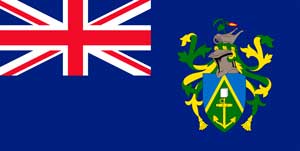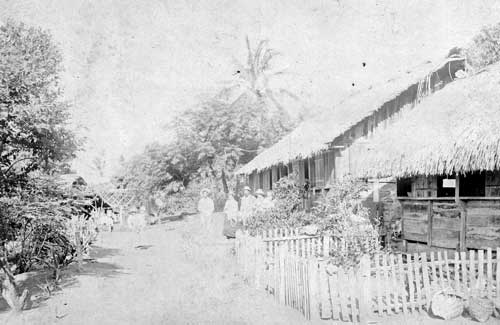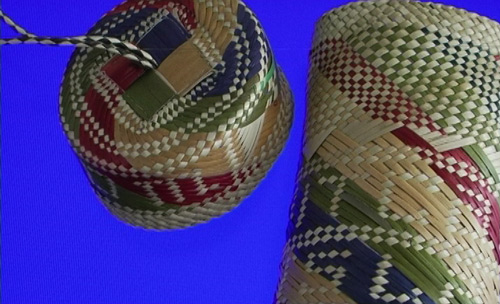Map
Flag

Quick facts
Official Name: Pitcairn
Indigenous Peoples: Pitkern (of Polynesian and British descent)
Official Languages: Pitkern (also Pitcairnese), English
Political Status: British Overseas Territory
Capital: Adamstown
Population: 56 (2014 est.)
Greeting: Whata way ye?
History and geography

Pitcairn is a group of four volcanic islands in the southern Pacific Ocean that form the last British Overseas Territory in the Pacific. The four islands – Pitcairn, Henderson, Ducie, and Oeno – are spread over several hundred miles of ocean and have a total land area of about 47 sq km (18 sq mi). Only Pitcairn, the second largest island measuring about 3.6 km (2.2 mi) from east to west, is inhabited. The islands’ administrative headquarters are situated in Auckland, New Zealand.
British Captain Philip Carteret of the HMS Swallow noted the island in 1767, having been spotted by Major Robert Pitcairn.
The islands are home to the descendants of the British vessel HMS Bounty mutineers and the Tahitians (or Polynesians) who accompanied them, an event retold in numerous books and films. This history is still apparent in the surnames of many of the islanders. With only about 56 inhabitants originating from four main families, Pitcairn is the least populous national jurisdiction in the world. The United Nations Committee on Decolonization includes the Pitcairn Islands on the United Nations list of Non-Self-Governing Territories.
When the Bounty mutineers arrived at Pitcairn in 1790, they found and largely destroyed a number of structures that had been left by Polynesians who had lived there earlier.
The tale of the mutiny of the English ship HMS Bounty is well known. The Bounty set sail in 1787 for a voyage to collect breadfruit seedlings to take to the West Indies for cultivation as food for slaves. Under the command of William Bligh, the Bounty left Spithead for the Pacific. After a difficult voyage, Bounty finally arrived off Tahiti the following year. Five months later the Bounty set sail again. However, when the time came to return to England, some of the crew wanted to stay on the island. In April 1789, three weeks after leaving Tahiti, Fletcher Christian and some of the ship’s crew mutinied, setting Captain Bligh and 18 of his loyal crew adrift in an open boat.
Most of the remaining crew on Bounty wanted to return to Tahiti, but Fletcher Christian knew that in time a British naval ship would come in search for them and Tahiti would be the most likely place they would look. Intent on finding a new home, the crew eventually found Pitcairn Island in 1790. Christian decided to settle there as the island had been misplaced on Admiralty maps and would thus be hard to find. Whether by plan or by accident, HMS Bounty was set afire. Remnants of the ship sank in what is now called Bounty Bay.
The settlers survived by farming and fishing, though the initial period of settlement was marked by serious tensions among them. Alcoholism, murder, disease and other ills took the lives of most mutineers and Tahitian men as well as a few women. John Adams and Ned Young turned to the scriptures, using the ship’s Bible as their guide, for a new and peaceful society.
The women played an important role in ensuring the survival of the island and even more so after the massacre. They knew how to tend gardens, catch fish and make traditional tools and canoes. They also had the most influence on raising the children.
The women had brought their own utensils from Tahiti and these were handed down from mother to daughter. The men had landed tools and other implements from Bounty and fashioned more as necessary. Food cooked in Polynesian stone-lined ovens, consisting mainly of yams, taro and bananas with coconut cream and an occasional pig, bird or goat was, in Polynesian style, served twice a day, at noon and nightfall. Clothes, first made from sail cloth from Bounty, were replaced by loin cloths and skirts of tapa, the traditional Polynesian fiber-cloth, beaten from the bark of the paper mulberry tree.
The Polynesians also converted to Christianity. They later converted from their original form of Christianity to Seventh-day Adventism, following a successful Adventist mission in the 1890s.
The group was isolated for about 25 years. After they were eventually discovered the survivors were relocated to Tahiti but soon made their way back to Pitcairn, missing their lifestyle. Later, they were relocated again, this time to Norfolk island. But once again, many of the Pitkerns moved back to their island.
The 20th century brought an end to European rivalry in the Pacific and naval visits to Pitcairn gradually diminished. Fortunately, with the mission ship, Pitcairn maintained contact with Tahiti, and merchantmen again began to call with increasing frequency until 1914. By then, the opening of the Panama Canal placed Pitcairn on the direct run to New Zealand. Many of the new visitors were liners carrying hundreds of passengers anxious to have mementos of the island, at the halfway point in the longest regular service in the world.
Currently, the people of Pitcairn grow and harvest a wide variety of fruits and vegetables for their own use. Fish are plentiful, as are lobsters. These are caught for meals and for trading aboard passing ships.
Tourism plays a major role on Pitcairn, providing the locals with 80 percent of their annual income. Tourism is the focus for building the future economy, focusing on small groups coming by charter vessel and staying at “home stays.” Providing accommodations is a growing source of revenue and some families have invested in private self-contained units adjacent to their homes for tourists to rent.
Arts and culture

About 10 passenger ships visit Pitcairn every year, creating a good source of revenue for artists and craftsmen. The Pitkerns are involved in creating wood crafts and curios. Typical woodcarvings include sharks, fish, whales, dolphins, turtles, vases, birds, walking sticks, book boxes, and models of the Bounty. Miro (Thespesia populnea), a dark and durable wood, is preferred for carving. Islanders also produce tapa cloth and painted leaves for sale and trade to visitors.
The people speak Pitkern, a creole language based on an 18th-century dialect of English and Tahitian. It is a primary language of Pitcairn Island, though it has more speakers on Norfolk Island. Unusually, although spoken on Pacific Ocean islands, it has been described as an Atlantic Creole.
